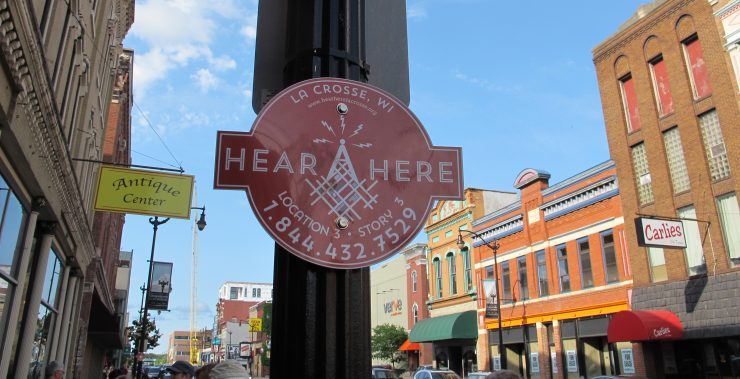by Jenny DeRocher
La Crosse, Wisconsin is a city of about 50,000 people. It sits between tree-covered bluffs and the winding Mississippi River. The city’s downtown area is like many other industrial Mississippi River towns with traces of train tracks, red brick buildings with ghost signs, curving one-way streets, and a large green park bordering the river with a walkway. There are coffee shops, every kind of bar you could ask for, and an old-timey ice cream and soda shop. There are oddities, too. For instance, there is an authentic riverboat sitting on the riverfront waiting to give tours up and down the river. Above it is a faded thirty-foot statue of an unidentified Native American man that, offensively, has no markings of the local Ho-Chunk Nation’s culture (though it is meant to be a tribute to their culture). Farther up the river on the north side of downtown sits the world’s largest six-pack, thanks to the city’s history with brewing beer.
When I went to college at the University of Wisconsin-La Crosse, the charms of the historic downtown area gave me the same happiness as other students. However, the town-and-gown divide is felt fiercely in the La Crosse community. As soon as I became a Public and Policy History Major, I was immediately swept into the arms of Dr. Ariel Beaujot and her public history project Hear, Here. I was a newbie in the world of studying history and didn’t really understand what public history was—I just knew I wanted to go to school for library science after college. I didn’t know it at the time, but Hear, Here isn’t just a public history project, it’s a community archiving project that brings archival sources literally onto the street. Hear, Here is an oral history project that focuses on place-based stories that take place in the downtown area. It’s a grant-funded community project that is meant to bridge the town-and-gown divide, bringing voices of all kind to the forefront.
As students and community members working on the project in a classroom-setting, we had to network within the city to find at least two stories to contribute to the project. Once we found a story and an interviewee we wanted to pursue, we did primary and secondary research on the story. We interviewed the story-tellers as short oral histories with first-person narratives, and then edited these stories so they were 2-5 minutes long. Once they were edited, they were put into a phone system and assigned a phone number. Then, in the locations that these stories happened, we placed street signs that had the phone number for the story on them (see picture). People walking in the streets of La Crosse’s downtown area can see the sign, call the phone number, and listen to someone’s story of something that happened in the exact location they are standing. Some of the stories took place the same year we collected them. Others were from oral histories collected in the 1970s and took place as early as the 1880s. On the website, you can click on the gray icons in the interactive map, listen to stories, and read their transcripts. There are currently fifty stories in the project.

The primary and secondary research each interviewer does for the stories is collected in an archival box at the University of Wisconsin-La Crosse Murphy Library Special Collections and Area Research Center. This box also includes CDs with the full-length interview for each story and the edited version as well. For ongoing outreach, Ariel runs a Hear, Here Facebook page, where she keeps followers up to date with tours, story editions, and international Public History news. Every few months, she runs free walking and bike tours for the public to highlight specific stories. In early 2017, there was also a poetry contest, where community members submitted poems responding to stories. Winners received a cash prize and their poems are now also in the phone system for listeners to hear on the street. When you call the number, you can even leave a message to give feedback for the project or to connect with Ariel to record your own story; she’s always collecting new stories until the project’s end in 2020.
Hear, Here brings the history of the everyday person to light. We didn’t collect stories that support the already well-recorded narrative of the city. We collected stories about African American men getting wrongfully arrested in 2014, a woman chaining herself to a building to keep it from being demolished, a student from China excited to eat ice cream somewhere President Obama had reportedly been before, a Canadian tourist experiencing the Mississippi River for the first time, and a local Ho-Chunk man expressing his distaste for the offensive statue that’s supposed to represent him and his culture. We specifically tried to collect stories from voices that are often overlooked and have historically been underrepresented. Some stories are fun, others give voice to discrimination a community member has experienced. In either case, Hear, Here stories are concrete evidence that everyone experiences La Crosse in their own way and each one of these ways matters to the city’s larger narrative
*Visit http://www.wisconsinhumanities.org/hear-here-in-la-crosse
